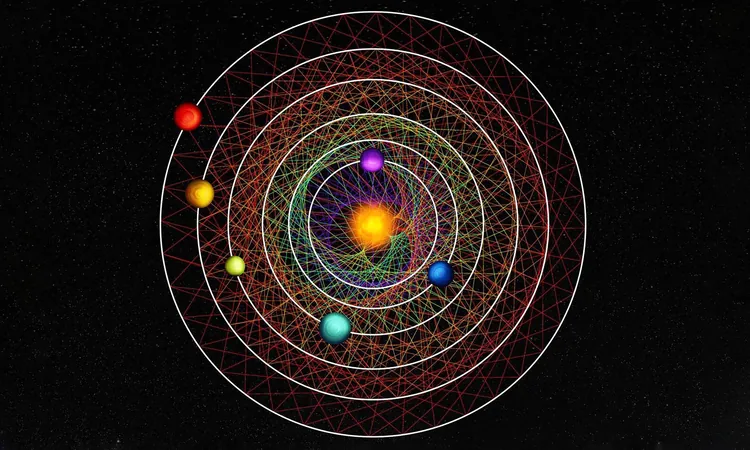
Discover the Mysteries of a Remarkable Six-Planet System in Perfect Resonance!
2025-01-13
Author: Jia
Introduction
Astronomers have recently uncovered an extraordinary six-planet system that presents a captivating alternative to conventional planetary arrangements. Dubbed HD110067, this unique system revolves around a single star, located approximately 100 light-years away in the northern constellation of Coma Berenices. The systematic choreography of these planets is what makes this discovery so thrilling.
Synchronized Orbits in HD110067
One of the standout features of HD110067 is that the orbits of the six sub-Neptune planets are synchronized in a manner known as resonance. This phenomenon means that their orbital periods maintain a fixed ratio, allowing them to move in harmony for millions, even billions, of years. Such precise synchronization is so exquisite that it evokes comparisons to musical tempos—akin to a cosmic symphony.
The discovery, led by researcher Rafael Luque at the University of Chicago, raises intriguing questions about how certain stars manage to host stable families of planets over extensive periods. The initial detection of HD110067's planetary family was made possible through NASA's Transiting Exoplanet Survey Satellite (TESS), which observed unusual dips in the star's brightness that indicated planetary transits. Further insights from the European Space Agency's CHaracterizing ExOPlanet Satellite (Cheops) confirmed the presence of this rare six-planet alignment.
A Closer Look at Sub-Neptunes
Sub-Neptunes—planets between the size of Earth and Neptune—are thought to be the most common type of exoplanets found in our galaxy. Their prevalence over massive gas giants like Jupiter makes them crucial for studying planetary formation. The HD110067 system provides a textbook example for researchers keen on understanding the composition, evolution, and potential for habitability of these intriguing worlds.
Many stars host at least one sub-Neptune, but the unique resonance pattern observed in this system offers scientists an opportunity to explore fundamental questions about planetary stability and development. The synchronized movements of these planets are not just an aesthetic wonder; they can reveal how planets interact gravitationally and maintain their orbital positions without interference from larger neighboring bodies.
The Importance of Harmonic Resonance in Planetary Systems
The formation of resonant systems typically involves initial conditions where planets have well-ordered orbits that nudge each other positively. However, this balance is fragile; significant gravitational disruptions from larger celestial objects can upset the established rhythm. Current estimates suggest that only about one percent of multi-planet systems can maintain such stable configurations over time, making the HD110067 system an invaluable opportunity for scientific inquiry.
The lack of large neighboring planets around HD110067 seems to have allowed this six-planet arrangement to endure, free from the gravitational upheaval that often disturbs similar systems. This stability offers insights into why certain planetary systems evolve cohesively while others become chaotic.
Unlocking the Secrets of the Universe
For scientists studying the birth and growth of planets, each meticulously structured system serves as a vital piece of the puzzle. The pristine harmonies of the HD110067 planets may provide a more accurate representation of early planetary consolidation processes, devoid of the disruptive influences often experienced in other systems. The goal is to refine our understanding of these planets' masses and densities, which will shed light on their internal structures and the potential presence of conditions conducive to liquid water.
With advanced observational tools and upcoming space missions, astronomers are eager to delve deeper into the mysteries these sub-Neptunes present. The knowledge gleaned from HD110067 not only seeks to answer questions about the history of its planets but also pushes the boundaries of our understanding of planetary dynamics on a cosmic scale.
A Call to Action for Astronomy Enthusiasts
The discovery of such a well-ordered planetary system sparks curiosity about whether other similar systems are hidden within our galaxy. Engaged enthusiasts and scientists alike see this as a thrilling opportunity to further our exploration of resonance phenomena in multidimensional celestial arrangements.
Ultimately, the implications of this research extend beyond our understanding of HD110067 itself. It challenges astronomers to seek out hidden resonances elsewhere and encourages exploration into the vast expanse of the universe to unravel the intricate stories our celestial bodies tell.
This remarkable find was officially documented in the prestigious journal Nature, making it a noteworthy highlight in the realm of astronomy.
Conclusion
Engage with us for more groundbreaking discoveries and keep yourself updated on the latest astronomical adventures! You won't want to miss what unfolds next in the universe!



 Brasil (PT)
Brasil (PT)
 Canada (EN)
Canada (EN)
 Chile (ES)
Chile (ES)
 Česko (CS)
Česko (CS)
 대한민국 (KO)
대한민국 (KO)
 España (ES)
España (ES)
 France (FR)
France (FR)
 Hong Kong (EN)
Hong Kong (EN)
 Italia (IT)
Italia (IT)
 日本 (JA)
日本 (JA)
 Magyarország (HU)
Magyarország (HU)
 Norge (NO)
Norge (NO)
 Polska (PL)
Polska (PL)
 Schweiz (DE)
Schweiz (DE)
 Singapore (EN)
Singapore (EN)
 Sverige (SV)
Sverige (SV)
 Suomi (FI)
Suomi (FI)
 Türkiye (TR)
Türkiye (TR)
 الإمارات العربية المتحدة (AR)
الإمارات العربية المتحدة (AR)